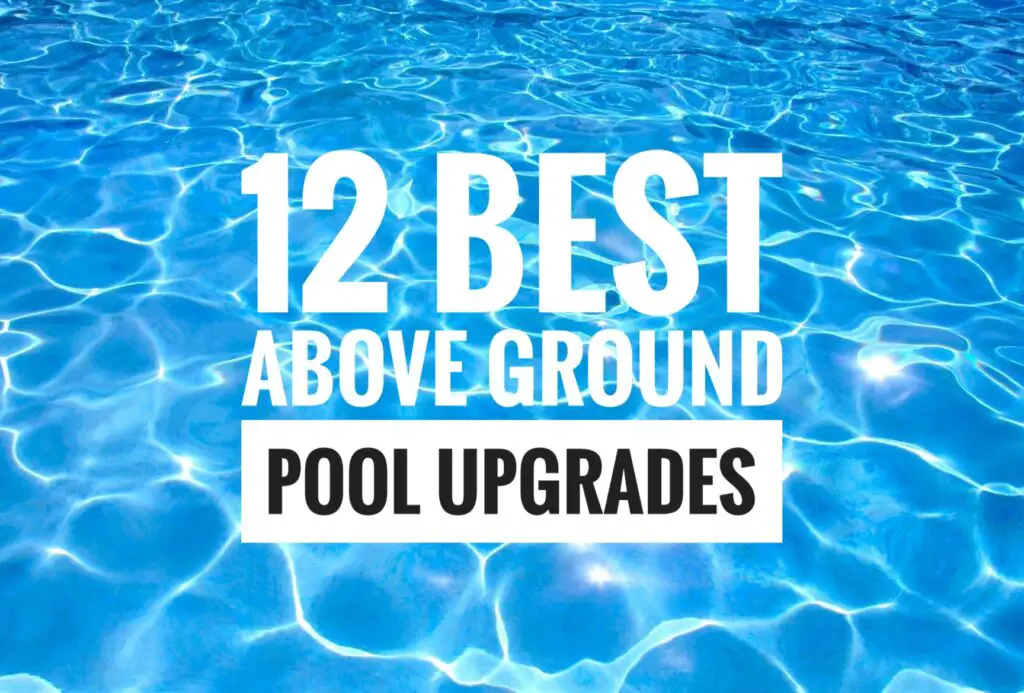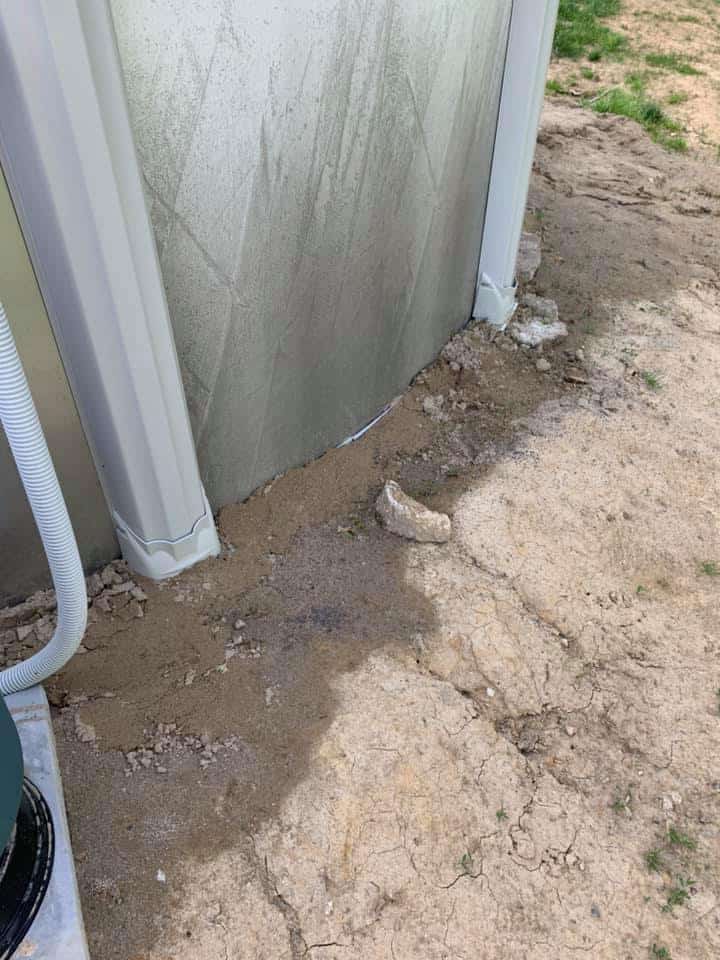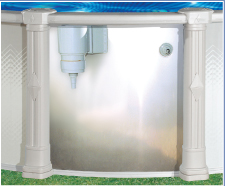Getting an above ground swimming pool is a great alternative to the now outrageously expensive in-grounds. But which pool do you get? And after deciding on the model, what options are best for it?

This is my 37th year installing and repairing above-ground swimming pools. In this time, I have seen a lot of things for above ground come and go.
The pool business is a lot like nature. Every year in nature, new species of life come into existence while many others go extinct. The same goes for the pool business with products. And with the pool business, many of the new things created won’t last but a year or two before going to the boneyard so to speak.
THOSE THAT STAND THE TEST OF TIME ARE USUALLY THE BEST THINGS
With the way products come and go, an old-timer like me learns that most of what’s new is complete garbage. Being around for a while also teaches you to respect things that last.
This list of upgrades or add-ons have all been around for a good, long while. This is not to say that some newer products aren’t good. I just won’t really know how good they are until they’ve been used in the real world for at least a couple of years.
12 GREAT OPTIONS FOR ABOVE GROUND SWIMMING POOLS
First off – A disclaimer. This list is for traditional metal-walled above ground pools. Soft-sided Intex/Coleman type pools don’t last as long and are much less universal in their design. They will not apply to this list.
The following list is in the order of what I recommend least to best. The lower the number, the more I recommend it.
#12 Floor Padding/ Liner Guard
A pool liner guard has become a popular add-on for above ground pools. In truth, this product does more for peace of mind than actual prevention or preservation.
I don’t mind installing liner guards and will recommend them, especially for DIYers. They do help at preventing nutgrass from growing through the liner and will prevent some sharp objects left in the earth from piercing it.
Installer’s tip: When using a liner guard/pad, put it down right before the liner goes in. Don’t bury it in the earth. That defeats most of its purpose.
#11 Foam Coving

Originally used only for above grounds on concrete, this add-on has become very common for all bottom types.
If installing on the earth, foam coving is not necessary, but I do recommend it especially for DIYers. Foam cove does make for a nicer job and will protect the liner from if there’s a wash-out from a leak.
To find out exactly what pool cove is, read here.
#10 Steps

Most pool packages come with just an A-frame ladder to get in and out of the pool. Above ground pool steps are a nice upgrade to only having ladder rungs in the pool.
Steps are good landing spots for small swimmers and make it easier for people to get in and out of the water. They do take up some swimming space, so consider that if you have a smaller pool. Above ground pool steps come in some different shapes and sizes, so choose one that fits your needs.
Some step/entry systems for above grounds will have steps on the outside of the pool going up and in the pool too. This is good for swimmers needing better and easier access like some elderly or people with special needs.
Steps are also needed for bigger swimmers. Most standard a-frame pool ladders will be rated for 300-350 pounds maximum. You can find some step systems with weight ratings as high as 600 pounds.
#9 Salt Chlorine Generator
Out of the many add-ons available for helping with pool chemistry, I will only recommend a chlorine generator. This is mostly because almost every other thing you can get to help maintain the pool is a waste of money.
With this being my 37th year in the pool business, I can remember when these salt chlorine generators came available. They have gotten much simpler in design and are now available widespread for above-ground pools.
I am a fan of salt systems, but don’t expect them to save you money. They won’t. What they will do is make it easier for you to maintain your pool, which a very good reason to have one.
Some will think that these salt systems will prematurely rust out above ground pools. I don’t, but just in case you do, learn about what “salt water-friendly” really means
#8 Pool Light (Over wall)
Lighting up the pool’s water at night is really nice. Pool lights for above grounds are fairly inexpensive, so it makes number eight on this list.
There are some different ways you can have a pool light for an above ground pool. You can get one that installs in the pool’s wall and requires a new hole, one that is part of the return jet and doesn’t require a new hole, and one that installs over the wall that doesn’t need a hole or use the return line.
I strongly prefer the light that goes over the wall and doesn’t make a hole or affect the return line.
There are also some solar floating lights that are kinda cool. I’m not a big fan of solar lighting though as it’s just not as strong or lasting as electric sourced lighting.
#7 Main Drain
Often people don’t know that they can have a main drain with an above ground pool. You can. They provide better water circulation and help keep the pool clean.
Some opt for an auto cleaner to get better circulation instead. I’m a fan of a main drain as auto cleaners can be problematic
Main drains for vinyl pools work and seal well. They have to be hard plumbed under the pool and connected to the pool’s equipment, so it’s a more detailed add-on than that others.
Learn more about main drains and above ground pools here
#6 J-Hook Type Liner
J-hook liners aren’t new, but they are the newest type of liner for above ground pools. And I like them the best.
Many pool packages will come with just a standard “overlap” type liner. They work OK but are designed to drape over the outside of the wall, which is less attractive than it not being seen.
Some will say that you can roll up, fold inward, or later cut the excess of an overlap liner. I say “why have to do that” when you can just have a j-hook liner instead.
Also, j-hook liners can have a nice tile pattern at the top of the pool. Overlaps cannot. And I rarely recommend a beaded type liner
#5 Stainless Steel Service Panel

This is an option that you won’t hear much about in this non-real world place called the internet. As a real-world pool installer, I highly recommend a stainless panel.
If you have seen as many above ground pools die a premature death as I have, then you would know that a service panel made from stainless steel is worth the extra money. Just ask any of the thousands of people who had to replace their pool because the wall rusted out at the skimmer or return fitting.
Learn what is a stainless steel service panel for above ground pools here.
#4 Resin Top Rails/ Resin Parts
Traditional metal-walled above ground swimming pools (not the cheaper soft-sided Intex type) have frames that can be made out of either steel, aluminum, resin, or a combination of all.
Usually, the more expensive upgraded above-ground models will have more frame parts made from resin instead of metal. This is a good thing as resin doesn’t corrode or rust.
The top rails of the pool made from resin are especially better. This is because the top rails are what pool users see and interact with the most. Resin will not get as hot in direct sunlight and won’t fade as much as coated steel or aluminum will.
#3 PVC hard piping the pool’s equipment
Here’s a fun and obvious fact: All swimming pools have to have a pump and filter attached to them. With above ground pools, the package will come with only plastic flex hoses to connect the equipment (pump and filter) to the pool.
These plastic flex hoses are the absolute weakest link of the entire pool and they will spring a leak and have to be replaced well before anything else wears out. A great solution to this is to replace those cheap hoses with PVC hard piping.
Like the main drain, this is an upgrade that can’t just be purchased. PVC pipe has to be cut and clued to fittings that connect the equipment to the pool’s skimmer and return. It’s an extra step and costs extra to have done but is worth it in the long run.
Oh, and when hard piping the pool’s equipment, add two valves so the two lines can be shut off while servicing.
#2 Upgraded Pump/Filter
The pump and filter are the lifelines of any swimming pool’s overall health and water quality. And unfortunately, some above ground pools come with cheap and undersized equipment (pump and filters).
Making sure you get a good quality and properly sized pump and filter is number two on this list of upgrades for a reason. These are your main components for maintaining your pool and keeping it clear.
You want to enjoy your swimming pool. And part of that enjoyment is being able to maintain it easy and well. Struggling with water quality because the equipment is poor sucks!
Take the extra steps and pay the extra money to make sure you get good equipment. Don’t rely only on the guy selling you the pool. He may be knowledgeable and steer you in the right direction. He may also just be a salesman that knows more about getting you to trust him than what you need for your pool.
#1 Heavy gauge liner
This is the number one upgrade that I recommend. Heavy gauge liners for above ground pools don’t cost much more and don’t require anything different during the installation.
When you buy an above ground pool, it usually is sold as a package. Sometimes, the package will come already with a heavy gauge liner. Sometimes it will come with only a standard, solid blue, overlap type liner.
The price difference between a heavy gauge liner and a standard one is usually under a hundred dollars depending on the size of the pool. This is worth the extra money as it will last at least 2-3 years longer before needing to be replaced.
When it comes to getting a heavy gauge liner, I don’t care if you only plan on having the pool for a year, are about to sell your house, or are broke and only have enough for a super basic pool. You still want to get a heavy gauge liner. Period.


Hi Dan, really enjoying your straightforward common sense articles as I try to learn. I was told that in Florida bottom drains are illegal. This is the one source of frustration I have…no button drain. Are they allowed in Florida and I was simply given inaccurate info? Thanks for your help!
As far as I know, main drains are allowed in Florida for above ground pools. There may be a municipality or two that doesn’t allow them though. You’ll have to check with your local building department.
Hi Dan. I am a first time pool owner and I am having an above ground pool installed next month. It’s a oval 15×30 seascape. The information on your website has been extremely helpful to me.
I was wondering if you wouldn’t mind sharing some recommendations.
I am interested in purchasing pool foam coving, floor padding and liner guard. Can you recommend an inexpensive place to buy and how much of it I’ll need? Also I read that you don’t recommend using the foam board insulation under the floor liner but I’d like to have a soft bottom floor that’s consistently even to walk on. In your opinion how can this be accomplished? I’m not installing the pool myself. I bought the pool from a store and installation was included in the package. I live in Chicago. Thanks.
Glad to hear it. You should be able to get the foam coving and floor pad anywhere as they are all about the same. You buy for the size pool you have.
A good installer will give you a good smooth bottom, but who knows who is doing your install. You can use foam board for the bottom and it should be fine as long as they install it to where moisture can escape. Check with them for that. They may charge you more for installing a foam bottom (even if you buy the boards).
Great. Thanks Dan. I’ll check with the installer. How many inches thick would you recommend I get the foam boards?
Whatever the thickness is for foam boards with backings. I think they are 3/4 inch. The foam boards without the backing can break and puncture too easily, although they can be used as well.
Dan, soon to be 1st time pool owner and my local shop recommends a quite pricey ($2,700) UV system, stating that it cuts down on 80 – 90% of chemicals needed. I can’t seem to find much info on the AGP fb page so I’m curious about your opinion on them. Thanks!!
If I’m not mistaken, UV kills (sanitizes) but does not get rid of (oxidize). It would then be impossible for chlorine reduction to be greater than 50% but more like %25 or something as oxidizing is often the bigger job. Plus, UV does nothing to reduce adjusting other factors like PH.
Until something cool comes out, I’m still a fan of the salt chlorine generator if I have to choose an addon.
I have a 33 ft. round above ground pool. WE want to purchase a robotic cleaner. Have found that cleaners for above ground pool only cover 30 ft. round. And suggestions ?? WE are looking for something good like a dolphin. Thank you very much.
Sorry. I’m not aware of this 30′ max issue. My thinking though is that it will work no problem on the 33′ pool. I like dolphin but they are expensive.
Dan,
Awesome website. Thanks for being a pool knowitall. I plan to use all twelve of your recommended upgrades, but I have a few of questions. Can I reasonably expect a steel wall pool to last 20 years in NW Florida a hundred yards from a salt water bay? Is it worth another 50% to get an all resin frame and composite wall pool vice one with a steel wall and stainless service panel? I also like the idea of a foam floor in the pool (polyethylene vice polystyrene). I’m trying to envision integrating a main drain into a foam floor. Perhaps leaving an area around the drain with a sand bottom would work and also provide some way for moisture to escape? Maybe with a composite wall you don’t care about moisture? I’m curious how the liner would lay across that foam to sand transition. Thanks again for your great above ground pool resource!
A steel wall pool lasting 20 years is not the norm. Resin-walled pools are still new and unproven(in my opinion), but in theory, they should last a very long time. Not sure yet if it’s worth the extra cost.
You can cut the foam around the main drain for the floor. This works well.